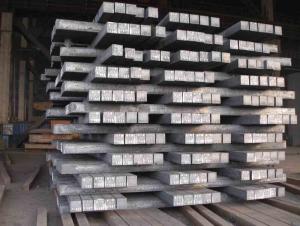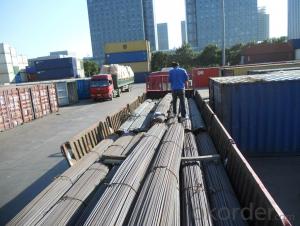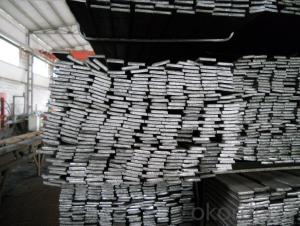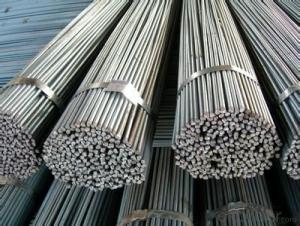Hot Rolled Square Bar with High Quality for Construction
- Loading Port:
- China main port
- Payment Terms:
- TT or LC
- Min Order Qty:
- 50 m.t.
- Supply Capability:
- 10000 m.t./month
OKorder Service Pledge
OKorder Financial Service
You Might Also Like
Product Description of Hot Rolled Square Bar with High Quality for Construction:
-Standard: GB,
-Grade: Q195 or equivalent.
-Chemical Composition:
Standard | Grade | Element (%) | ||||
GB | Q195 | C | Mn | S | P | Si |
0.06~0.12 | 0.25~0.50 | ≤0.050 | ≤0.045 | ≤0.30 | ||
Measures of HR Square Bar (small measures):
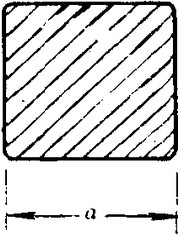
(Section of HR Square Bar)
-Length of a side and Theoretical weight of Square Bar.
Length of a side(mm) | Theoretical weight(kg/m) | Length of a side(mm) | Theoretical weight(kg/m) |
7 | 0.385 | 22 | 3.80 |
8 | 0.502 | 24 | 4.52 |
9 | 0.636 | 25 | 4.91 |
10 | 0.785 | 26 | 5.30 |
11 | 0.950 | 28 | 6.15 |
12 | 1.13 | 30 | 7.06 |
13 | 1.33 | 32 | 8.04 |
14 | 1.54 | 34 | 9.07 |
15 | 1.77 | 36 | 10.17 |
16 | 2.01 | 38 | 11.24 |
17 | 2.27 | 40 | 12.56 |
18 | 2.54 | 42 | 13.85 |
19 | 2.82 | 45 | 15.90 |
20 | 3.14 | 48 | 18.09 |
21 | 3.46 | 50 | 19.63 |
Notes:
1, The theoretical weights in the list, base on the density of 7.85 g/cm3.
2, Formula for theoretical weight of Square bar: (length of a side)2 * 0.00785
3, The numbers with *mean that they are not regular or we don’t offer them.
-Regular length of Square Bar:
Steel | Length of a side (mm) | Length of steel (m) |
Normal steel | < 25 | 4~10 |
> 25 | 3~9 | |
Steel of high quality | All measure | 2~6 |
Tool steel >75 | 1~6 |
Usage/Applications of Hot Rolled Square Bar with High Quality for Construction:
-The Square Bar is normally used as structure steel.
-Row material for other structure steel like steel angles, channels, I-beams, H-beams, etc…
Packaging & Delivery of Hot Rolled Square Bar with High Quality for Construction:
-Packing Detail: The products can be packed in bundles by steel wires.
-Marks: We make tag marks and color marks. The tag marks with white background and red company logo will be tied up to each bundle of the products. The information is usually including basic information of products and company and other information requested by customers. As for color marks, we will paint both ends of bundles to make sure that it will be more convenient for customers to distinguish them from other products.
-Delivery Detail: 30~45 working days after receive buyer’s T.T. or L/C.
Transportation of Hot Rolled Square Bar with High Quality for Construction:
-The products can be delivered by bulk vessel or by container. As for container, products with the length of 6m will be loaded in 20’ container, with 9m or 12m, in 40’ container.
-The maximum quantity of loading of container is 25 tons.
-The products are usually transported to the nearest port from the production place.
FAQ:
Q1: Why buy Materials & Equipment from OKorder.com?
A1: All products offered byOKorder.com are carefully selected from China's most reliable manufacturing enterprises. Through its ISO certifications, OKorder.com adheres to the highest standards and a commitment to supply chain safety and customer satisfaction.
Q2: How do we guarantee the quality of our products?
A2: We have established an advanced quality management system which conducts strict quality tests at every step, from raw materials to the final product. At the same time, we provide extensive follow-up service assurances as required.
Q3: How soon can we receive the product after purchase?
A3: Within three days of placing an order, we will begin production. The specific shipping date is dependent upon international and government factors, but is typically 7 to 10 workdays.
Images:
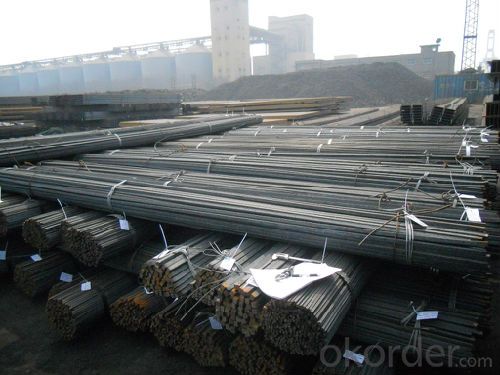
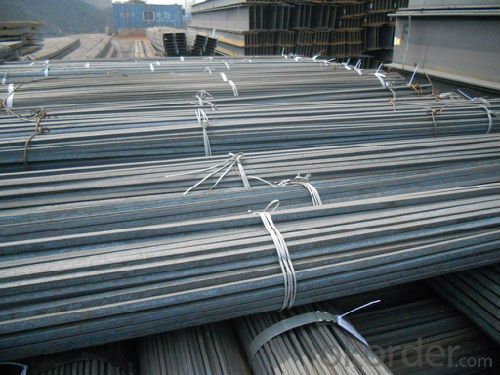
- Q:How do you use a steel square to check the flatness of a surface?
- To use a steel square to check the flatness of a surface, place the square on the surface and observe if there are any gaps or spaces between the square and the surface. If the square lays flat and there are no gaps, then the surface is considered to be flat.
- Q:Can a steel square be used for checking the squareness of a door opening?
- A door opening's squareness can be assessed using a steel square. This versatile tool, also known as a framing square or carpenter's square, is typically crafted from steel and features markings for angle measurement and right angle verification. With its 90-degree angle, the steel square proves useful for checking the squareness of various objects, including door openings. To examine the squareness of a door opening using a steel square, one must position the square against the door jamb or frame's edges, ensuring a flush and flat fit on both sides. By observing the alignment of the square's edge against the door jamb, one can determine if the opening's corners form perfect 90-degree angles or deviate from a square shape. If the steel square fits flawlessly against both sides of the door jamb, with no gaps or overlaps, then the door opening is square. However, the presence of a gap or improper alignment with the edges indicates that the opening is not square, necessitating adjustments to ensure the door's proper installation. In summary, a steel square serves as an effective tool for evaluating the squareness of a door opening. Its accurate measurement and assessment capabilities contribute to ensuring the proper fit and functioning of the door post-installation.
- Q:How do you use a steel square to find the center of a square?
- To find the center of a square using a steel square, place the square diagonally across the corners of the square. Then, draw lines connecting the midpoints of opposite sides of the square. The point where these lines intersect is the center of the square.
- Q:What are the different techniques for using a steel square in metalworking projects?
- In metalworking projects, there are multiple techniques available for utilizing a steel square. Here are some commonly employed methods: 1. Measurement and marking: A primary function of a steel square is to measure and mark precise angles and lengths on metal. By aligning the square with the desired angle or length and placing it against the metal's edge, accurate measurements can be made and the metal can be marked accordingly. 2. Verification of squareness: Steel squares are also useful for checking if metal components are square or perpendicular. By positioning the square against the edges or corners of the metal, it becomes possible to determine if they are perfectly square or if any adjustments are necessary. 3. Tool and machinery setup: Steel squares can assist in setting up tools and machinery for metalworking projects. By aligning the square with the components of the tool or machine, correct positioning and desired angles can be ensured. 4. Creation of right angles: Steel squares are excellent for creating right angles in metal. By utilizing the square as a guide and placing it against the metal's edge, precise cuts or bends can be made to achieve perpendicular edges. 5. Flatness examination: Steel squares can be employed to check the flatness of metal surfaces. By placing the square on different areas of the metal and observing any gaps or inconsistencies, it becomes possible to determine if the surface is flat or if further work is required. 6. Transfer of measurements: Steel squares can also be used to transfer measurements from one piece of metal to another. By aligning the square with the measurement on the first piece and subsequently marking the same measurement on the second piece, accuracy in metalworking projects can be ensured. In conclusion, a steel square is a versatile tool in metalworking projects, enabling precise measurements, angle checking, squareness verification, and assistance in various other tasks.
- Q:Can a steel square be used for porch post layout and installation?
- Yes, a steel square can be used for porch post layout and installation. Steel squares are versatile tools commonly used in carpentry and construction. They can be used to measure and mark angles, ensure accurate right angles, and aid in laying out and positioning posts and beams. The durability and precision of a steel square makes it suitable for various tasks, including porch post layout and installation.
- Q:How do you use a steel square for marking diagonal lines?
- To mark diagonal lines using a steel square, begin by placing the square onto the surface or material where the marking is desired. Ensure that one side of the square aligns with the material's edge. Then, take a pencil or marker and position it against the opposite side of the square, specifically at the desired starting point for the diagonal line. Afterward, rotate the square in a manner that aligns the intended diagonal line with the material's edge. Keep the square firmly against the material to ensure accuracy, maintaining its stability. While still holding the pencil or marker against the square, gradually and cautiously slide it along the square's edge, tracing the diagonal line. While moving the square along the material, you will notice a distinct and straight diagonal line left by the pencil or marker. Repeat this procedure for any additional diagonal lines that need marking. It is crucial to maintain a steady hand and consistently apply pressure to achieve precise and accurate markings. Always remember to double-check the alignment of the square and your measurements before proceeding with any cutting or further work based on the marked lines.
- Q:How does a steel square assist in determining the correct angle for a beaded joint?
- There are several ways in which a steel square can be utilized to determine the correct angle for a beaded joint. To begin with, the steel square possesses a 90-degree angle that can be employed as a point of reference to ensure that the beaded joint is perfectly perpendicular to the workpiece. By placing the square against the workpiece and aligning it with the joint, one can visually verify whether the joint is at a right angle or necessitates adjustment. Furthermore, the steel square enables the measurement and transfer of angles. Along its edges, the square typically features various degree markings that facilitate precise angle measurements. This proves particularly advantageous when dealing with beaded joints that require specific angles, such as mitered corners or angled cuts. By utilizing the square as a guide, one can accurately mark the desired angle on the workpiece and guarantee a precise beaded joint. Moreover, the steel square can function as a guide during the cutting or shaping of materials for the joint. By aligning the square with the workpiece and marking the desired angle, one can utilize the square as a reference point during the cutting or shaping process. This aids in achieving accurate and consistent angles across multiple pieces, resulting in a well-fitted and aesthetically pleasing beaded joint. In summary, a steel square proves indispensable in determining the correct angle for a beaded joint by virtue of its ability to provide a 90-degree reference, facilitate angle measurements and transfers, and serve as a guide during cutting and shaping operations. Its versatility and precision make it an essential tool for ensuring the accuracy and quality of beaded joints.
- Q:Can a steel square be used for measuring roof pitch?
- Yes, a steel square can be used for measuring roof pitch. A steel square, also known as a framing square or carpenter's square, is a versatile tool used in carpentry and construction. It has a long blade and a shorter tongue, forming an L-shape. The blade of the square is marked with various angles and measurements, making it useful for determining roof pitch. To measure the roof pitch using a steel square, you can place the longer blade of the square along the roof rafters or trusses, ensuring that it is aligned with the bottom edge of the roof. Then, you can adjust the angle of the square until the shorter tongue rests on the roof surface. By reading the measurement on the blade where it intersects the desired pitch, you can determine the roof pitch accurately. The steel square's ability to measure angles and pitch makes it a reliable tool for determining roof slope and ensuring proper installation of roofing materials. However, it is essential to note that using a steel square may require some knowledge and practice to obtain accurate measurements. Additionally, other specialized tools, such as a digital inclinometer or a laser level, may provide more precise measurements for roof pitch in certain circumstances.
- Q:How do you use a steel square to measure the height of a workbench?
- To use a steel square to measure the height of a workbench, you can follow these steps: 1. Place the steel square upright on a flat surface, ensuring that it is perpendicular to the ground. The shorter arm of the square should be at the bottom. 2. Position yourself at the side of the workbench where you want to measure the height. 3. Hold the steel square against the side of the workbench, aligning the bottom edge of the shorter arm with the floor or ground. 4. Adjust the square until the longer arm is aligned with the top surface of the workbench. Make sure the square is straight and parallel to the side of the workbench. 5. Once the square is properly aligned, look at the measurement scale on the longer arm. Read the measurement where the top surface of the workbench intersects with the scale. This will give you the height of the workbench. Remember to take accurate measurements and ensure the steel square is properly aligned to get an accurate height measurement for your workbench.
- Q:Glass partition, square box outsourcing 1mm thick stainless steel, glass middle is how to set the quota
- Can consider to increase the insurance factor, the edge of the glass with epoxy resin and solid wall such as granite wall adhesion (which went to the production of glass curtain wall) will not allow the use of styrofoam! Because of adhesive power, shear resistance and so on are poor.
1. Manufacturer Overview |
|
|---|---|
| Location | |
| Year Established | |
| Annual Output Value | |
| Main Markets | |
| Company Certifications | |
2. Manufacturer Certificates |
|
|---|---|
| a) Certification Name | |
| Range | |
| Reference | |
| Validity Period | |
3. Manufacturer Capability |
|
|---|---|
| a)Trade Capacity | |
| Nearest Port | |
| Export Percentage | |
| No.of Employees in Trade Department | |
| Language Spoken: | |
| b)Factory Information | |
| Factory Size: | |
| No. of Production Lines | |
| Contract Manufacturing | |
| Product Price Range | |
Send your message to us
Hot Rolled Square Bar with High Quality for Construction
- Loading Port:
- China main port
- Payment Terms:
- TT or LC
- Min Order Qty:
- 50 m.t.
- Supply Capability:
- 10000 m.t./month
OKorder Service Pledge
OKorder Financial Service
Similar products
New products
Hot products
Related keywords






















